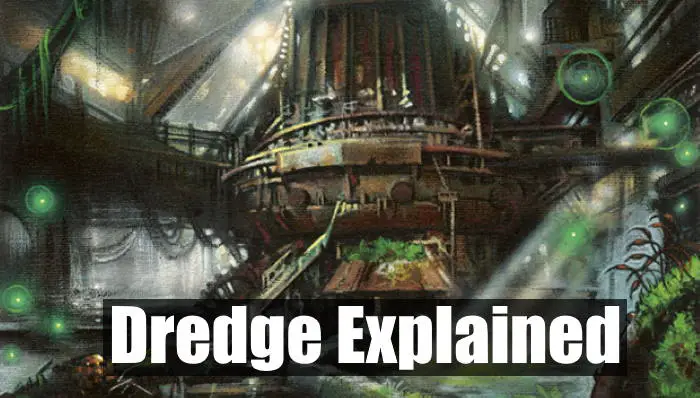Dredge is a very powerful mechanic in Magic: The Gathering but how exactly does it work? What is it that dredge does to make it so powerful? All this and more will be addressed in this article
Dredge is a recursion mechanic in Magic: The Gathering that works only while the card with dredge is in the graveyard. If you were to “Dredge X”, when you were to draw a card, you could mill X instead, and put the card with dredge back into your hand.
When it comes to understanding dredge, it can be pretty complicated. In this article, you will understand what dredge does, how to use it, and why it is so powerful.
What is Dredge?
Dredge is a mechanic that was introduced in 2005 with Ravnica: City of Guilds. This mechanic was given to the Golgari guild as one of their main keywords. Dredge has only been printed on 14 total cards, which is incredibly small and primarily on green/black cards. In more recent sets though there was a red card that dredge was printed on, Shenanigans.
How Does Dredge Work?
This keyword, dredge, isn’t on many cards and as a result, can be a little confusing. Let’s take a look at the official definition from Wizards.
702.52a Dredge is a static ability that functions only while the card with dredge is in a player’s graveyard. “Dredge N” means “As long as you have at least N cards in your library, if you would draw a card, you may instead mill N cards and return this card from your graveyard to your hand.”
Magic: The Gathering rule 702.52a
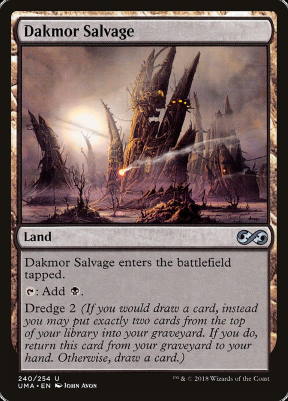
To help clarify this definition let’s use the example of Dakmor Salvage. This land has dredge 2. That means that if you were to draw a card for any reason, you could mill 2 instead. If you do, you put Dakmor Salvage back into your hand. Once you realize that this is all dredge means, it really isn’t too complicated.
How Do You Play A Dredge Deck?
A dredge deck is a deck that is focused on the graveyard. A dredge deck doesn’t solely have to have cards with dredge in it. In fact, dredge decks are usually better with cards that interact with the graveyard. An example of this, is a very popular card in legacy dredge, Narcomoeba.
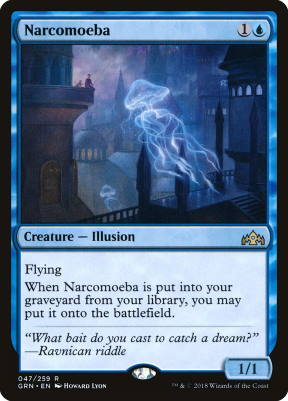
Narcomoeba benefits from cards with dredge. When you dredge “X”, and Narcomoeba is one of the cards put into the graveyard, it may be put onto the battlefield. This is very beneficial. This situation generates card advantage, which helps you win the game. While you do get to get the card back with dredge, you essentially get a 1/1 flyer for free.
In the same respect, there are many other cards that benefit from dredge in formats like modern and legacy. Prized Amalgam and Creeping Chill are just two other cards that help a modern dredge deck.
Why Is Dredge Powerful?
This keyword leads to a very powerful and tough-to-deal-with strategy. Initially an instance of “dredge X” was designed as a cost. Dredge is so powerful because it takes that cost and turns it into an incentive. To phrase this another way, instead of having to “lose” cards from the top of your deck, you get to use those as additional resources.
As established above, dredge lets you generate card advantage. Card advantage is also powerful in any deck and can help lead toward victory. The way that dredge synergizes with many cards in generate a very unique and powerful experience.
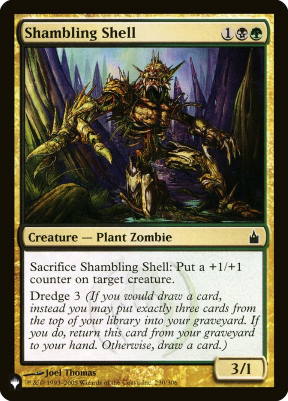
Another reason why dredge is so powerful, it isn’t prone to most removal. When you sit down to play a “Best of three” game, dredge has a higher likelihood of winning the first game. This is because most decks will have cards that say, “Destroy target creature”. To most decks, this can be devastating. To dredge, it is beneficial. The only caveat is cards like Path to Exile that would exile your creature instead of sending it to the graveyard.
Can You Dredge With No Library Or With Multiple Cards?
Lots of people have asked me, “Can I dredge with not enough cards in my library?”. In other words, can you dredge 6 with Golgari Grave-Troll if you have 5 or less cards in your library. In short, the answer is no. Below is the exact rule stating this.
702.52b A player with fewer cards in their library than the number required by a dredge ability can’t mill any of them this way.
Magic: The Gathering Rule 702.52b
You can only dredge the exact amount of cards that the card has you dredge. That means that if you choose to dredge with Golgari Grave-Troll you must mill exactly 6 cards this way.
Another question I get asked all the time is, “Can I dredge multiple times if I have multiple cards with dredge in my graveyard?” The answer to that question is yes! However, it is conditional.
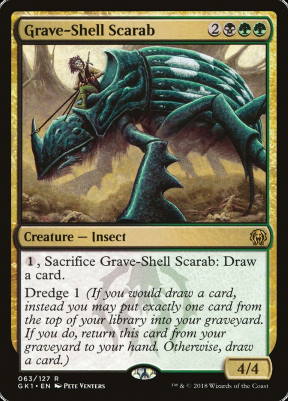
For example, if you have 2 copies of Shenanigans in your graveyard and you were going to draw a card, both copies of Shenanigans would trigger. If you were to choose to dredge, you would mill one cards and put the first copy of Shenanigans in your hand. The second copy of the card would try to dredge but without an additional instance of drawing a card, the second copy’s dredge ability will fizzle.
Another example would be if you had an instance of “draw 2 cards”. Due to the way MTG words drawing cards, “draw 2 cards” can be viewed as “draw 1 card” twice. With this, and the previous example in mind, you would then be able to use the second copy of Shenanigans dredge ability. This would let you use both instances of dredge off of a “draw 2 ability”.
Is Dredge A Combo Deck?
Dredge is a keyword that has affected many different formats. No matter the format, dredge decks are typically considered combo decks. A combo deck can be defined as a deck that quickly wins the game due to a combination of effects between cards. To better understand what a combo deck is and how it wins check out this great article about MTG Modern: A Getting Started Guide.
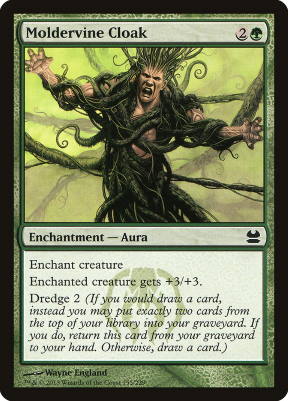
Let’s use that example of Narcomoeba from earlier. When Narcomoeba is milled, it will come onto the battlefield. What if you dredge 6 with Golgari Grave-Troll and at least 4 of those cards are non-land cards.
It’s highly probable that you could mill a Narcomoeba, a Prized Amalgam, and 2 Creeping Chills. Then maybe the other two cards are lands. After this action, you would get a 1/1 flyer, a 3/3 zombie, and deal 6 damage to your opponent and gain 6 life.
Not only is this a great representation of how dredge is a combo deck, but it is also a great example of how dredge is a powerful deck.
What Are The Best Dredge Cards?
7. Shenanigans

| Pros | Cons |
| Only Red Dredge Card | There are usually more efficient options for artifact removal |
| Less than $1 | Sorcery speed |
Shenanigans does not appear in many constructed competitive decks other than a hand full of blue-red combo/control decks. However, this card can show up in tons of commander decks and its cheap cost causes it to be pretty decent artifact removal in mono-red. Sadly, if the commander deck has green, there are many options that would be more optimal and wouldn’t necessarily cost more.
6. Golgari Thug
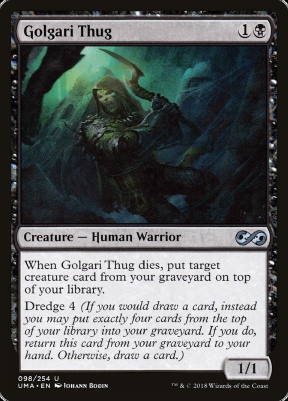
| Pros | Cons |
| Synergistic with dredge | Is only a 1/1 creature |
Golgari Thug is a staple in most modern and legacy dredge decks. This card achieves what the deck aims to do, dredge. On top of that, this card helps you put a creature back on top of your library. This can help if you are actually trying to draw a certain creature.
5. Necroplasm
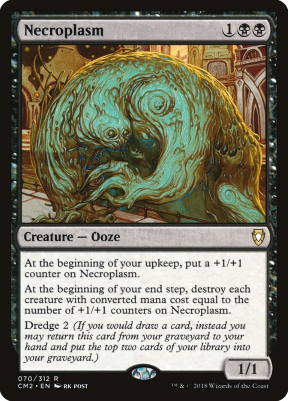
| Pros | Cons |
| Inexpensive | Will destroy your own creatures. |
| Small-scale recurring | It is not a “May” ability |
This card is a very unique magic card. While it does appear to be a three-mana 1/1, it is really a small-scale
Because this card is very predictable, it can be hard to catch anybody by surprise with this card. It can be a very powerful addition to a commander deck though as it is a creature that can continuously take out smaller creatures.
4. Stinkweed Imp
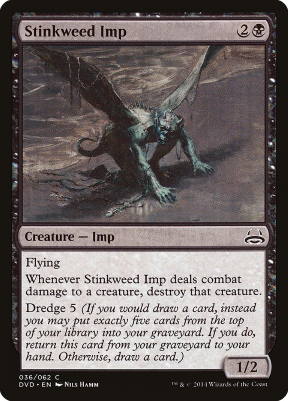
| Pros | Cons |
| Flying creature that is a great chump blocker | Not great in decks that don’t focus around dredge |
| Dredge 5 |
Stinkweed Imp is a very solid card in a dredge deck. It is a tough blocker for the more aggressive opponents, it flies, and it has dredge 5. No opponent is going to want to trade one of their creatures for this little guy. Especially because when this card is in the grave, you get to dredge 5 and further your game plan even more.
3. Dakmor Salvage

| Pros | Cons |
| The only land with dredge | Enters tapped |
| Tough to get into the graveyard |
This is the only land in MTG that has the keyword dredge on it. That is what helps make this land unique and powerful. While this land is strong, it does have some minor drawbacks. One of the more obvious drawbacks is this land comes in tapped. That can be hard, not impossible though, to work within a competitive environment. The second drawback is that not every deck has a way to get this card in the graveyard to be able to dredge again.
An example of where this card can work is in a The Gitrog Monster deck. Because of Gitrog’s ability, you can sacrifice this card on you upkeep, dredge instead of being able to draw a card, then draw for turn, and be able to use Dakmor Salvage as your land drop for the turn. This way you will be set up to do it all over again next turn.
2. Golgari Grave-Troll

| Pros | Cons |
| Dredge 6 | Banned in Modern |
| Has a way to put itself back into grave | 5 mana to cast |
| Relatively inexpensive |
This is a powerhouse of an MTG card. This card lets you dredge 6. That is incredible enough on its own. On top of that Golgari Grave-Troll can enter with a ton of counters in the late game. There might be some creatures that are “stuck” in your graveyard that this card can take advantage of.
Then to make Golgari Grave-Troll even more appealing, this card has the ability to regenerate itself. Which on the surface seems just ok but in actuality is a fantastic ability for this card to have. The greatest feature of this card is no doubt dredge 6.
But you can only dredge if this card is in the graveyard. By activating the regenerate ability, it will remove a +1+1 counter from Golgari Grave-Troll. When this card has no +1+1 counters on it and because it is a 0/0 otherwise. It will die and then end back up in the graveyard.
Another thing to consider when discussing Golgari Grave-Troll, is that this card is 5 mana. Which can be a little expensive. When you do cast this card though, there is a pretty good chance that there are no creature cards in your graveyard. That would mean that Golgari Grave-Troll would die and go to the graveyard. This also means that you are set up to dredge 6 on your next draw and keep your deck going.
Sadly, a huge downside is that Golgari Grave-Troll is banned in the format that it would do best in, modern.
1. Life From the Loam
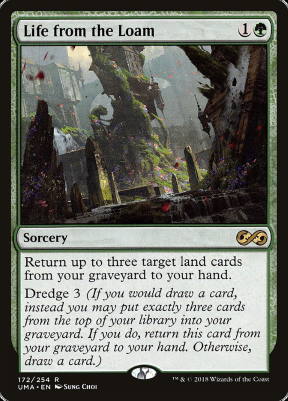
| Pros | Cons |
| Synergizes with itself | Not great in a deck not focused around the graveyard |
| Ramps you lands | |
| Lets you dredge 3 | |
| Synergizes perfectly with fetch lands |
This is without a doubt the best dredge card. Life from the Loam does an amazing job of letting you benefit from some of the cards you might not be able to benefit from normally. These cards of course being the lands. Getting more lands back can help you curve out in your deck or synergize even greater. This card also helps you ramp in decks that use the graveyard like this.
Life from the Loam is such an important and vital card in dredge. Between the combination of this card and a couple of fetch lands, this will let you thin your deck from lands. You would want to thin your deck from lands so that way when you dredge, you can dredge the cards you want to see like Narcomoeba or Prized Amalgam. Plus, that also means that you will never miss your land drops, giving you tons of mana to play within the game.
Life from the Loam is the most important card in most dredge decks.
End Step
Hopefully, this article has been illuminating for you all about dredge. We went over some of the most powerful cards and how they synergize with the other cards in dredge decks. Dredge is such a fun and unique mechanic to only a few cards all across the game.
